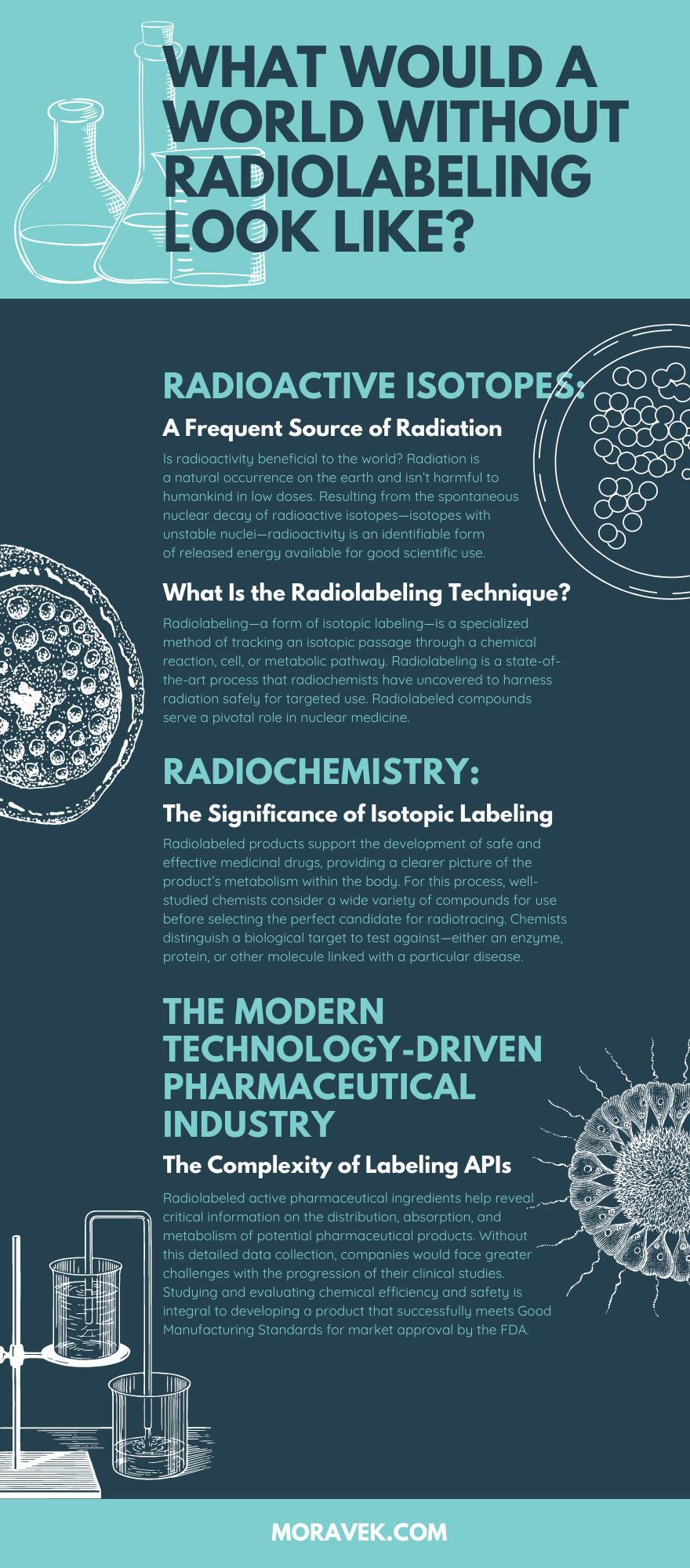
How does radioactivity impact our modern world? Since life’s earliest estimated beginnings, all living organisms have been exposed to various sources of naturally-occurring background radiation. This type of radiation appears either from the cosmic rays in the sky or the soil and rock of the earth.
As all atoms in the universe exist with either stable or unstable isotopes, radioactivity is an inevitability of life. Without naturally occurring radioactivity, life wouldn’t exist at all—its generated heat has prevented the earth’s core from freezing solid for billions of years.
Radioactivity has numerous applications in our world, including that of radiolabeling. Radiolabeling is the most dependable, accurate, and sensitive method for molecule identification or detection. Modern-day science and medicine have radiolabeling to thank for their research-based discoveries and innovations. Ergo, what would a world without radiolabeling look like? Our current society certainly wouldn’t be the same without this technique—that’s one fact for sure. Let’s examine closer the critical influence of this type of isotopic labeling.
Radioactive Isotopes: A Frequent Source of Radiation
Is radioactivity beneficial to the world? As mentioned above, radiation is a natural occurrence on the earth and isn’t harmful to humankind in low doses. Resulting from the spontaneous nuclear decay of radioactive isotopes—isotopes with unstable nuclei—radioactivity is an identifiable form of released energy available for good scientific use. At the core, radioactivity is not an innately biological occurrence. Rather, it’s a physical phenomenon that allows people to use radioactive material for vital life purposes.
This anomalous type of energy has been present on the planet since the start of the universe. Yet radioactivity did not become a source of serious scientific study until its discovery in 1896. French scientist Henri Becquerel is known for his discovery of natural radioactivity. Conversely, the initial use of artificially-made radioisotopes in the 1930s is credited to Marie and Pierre Curie. A greater understanding of the basic qualities of radioactivity has since provided the world with insight into the laws that command Mother Nature.
Through this research, scientists discovered that the measure of radioactivity from an isotope depends on the percentage of erratic nuclei and the frequency level of their decay. Knowledge of this characteristic measurement is key to utilizing and handling these properties in radiochemical applications.
What Is the Radiolabeling Technique?
Radiolabeling—a form of isotopic labeling—is a specialized method of tracking an isotopic passage through a chemical reaction, cell, or metabolic pathway. Radiolabeling is a state-of-the-art process that radiochemists have uncovered to harness radiation safely for targeted use. Radiolabeled compounds serve a pivotal role in nuclear medicine. This utilization is no different from employing fire or the medicinal properties of plants, which hold the same risky potential and power of doing harm. Chemists are extremely cautious with the handling and disposal of radioactive material in labs specially equipped with equipment to handle radioactivity.
Radiochemistry: The Significance of Isotopic Labeling
What would a world without radiolabeling look like? Many radiolabeled compounds are used for biological research, including metabolism studies. Yet this method for labeling molecules with radioactive elements also allows scientists to follow the metabolism of drugs in the midst of development. Using this technique, scientists can track and observe the selected isotope as it moves through atomic cells or changes positions throughout chemical reactions.
Essentially, radiolabeled products support the development of safe and effective medicinal drugs, providing a clearer picture of the product’s metabolism within the body. For this process, well-studied chemists consider a wide variety of compounds for use before selecting the perfect candidate for radiotracing. Chemists distinguish a biological target to test against—either an enzyme, protein, or other molecule linked with a particular disease. The metabolism is the main factor carefully evaluated to choose the ideal candidate for labeling.
For this reason, radiolabeling is exceptionally advantageous for present-day drug-discovery projects. Radioisotopic labeling provides chemists with a one-of-a-kind tool in their exclusive toolbox to support the project objectives of pharmaceutical companies or research institutions.
The Modern Technology-Driven Pharmaceutical Industry
Radiolabeling remains to be a specialized application of radioactivity for diverse groups and operations worldwide. The project scopes of this type of radiochemistry can extend into a wider range of industries, yet as mentioned above, pharmaceuticals put the technique of radiolabeling best into practice. The modern pharmaceutical industry faces numerous challenges, including ever-changing techniques, innovative technological advancements, and strict regulatory controls.
The Complexity of Labeling APIs
Radiolabeling is the leading accessible technology for the labeling of active pharmaceutical ingredients. Active pharmaceutical ingredients—known as APIs most commonly—are medicinal application agents created through varying chemical combinations. During early phase clinical trials, the labeling of APIs and their metabolites is essential for gaining project-critical quantitative data.
Radiolabeled active pharmaceutical ingredients help reveal critical information on the distribution, absorption, and metabolism of potential pharmaceutical products. Without this detailed data collection, companies would face greater challenges with the progression of their clinical studies. Studying and evaluating chemical efficiency and safety is integral to developing a product that successfully meets Good Manufacturing Standards for market approval by the FDA.
As time goes by, modern APIs—and their diverse distribution procedures—have become steadily more complicated. This complexity brings on an assortment of synthetic obstacles and obligations for those in the pharmaceutical industry. Manufacturers with isotope laboratories must increasingly update their facilities with fresh technologies and make authoritative use of the latest radiolabeling approaches to create these products. Quality-focused API production necessitates this heightened level of expertise, attention, and commitment.
Radiolabeling Services and Solutions
Moravek understands what a world without solutions-oriented radiolabeling would look like. Look no further for the proficiency and qualifications required for quality custom campaigns. We remain fully committed to the advancement of human health.
As a trusted contract manufacturer, Moravek provides an unrivaledisotope labeling servicefor clientele performing research and trials.As a world-renowned supplier of high-quality radiolabeled compounds, we support the drug development process with our state-of-the-art services.
Our team of radiochemistry specialists comes from various backgrounds, using expert knowledge and high-tech facilities to fulfill current industry needs. As one of the largest radiochemistry groups around, Moravek is able to select the most appropriate label position for studies that are both efficient and metabolically stable. Uncover further information about our customized carbon-14 (14C) and tritium (3H) radiolabeling solutions on our website today.

